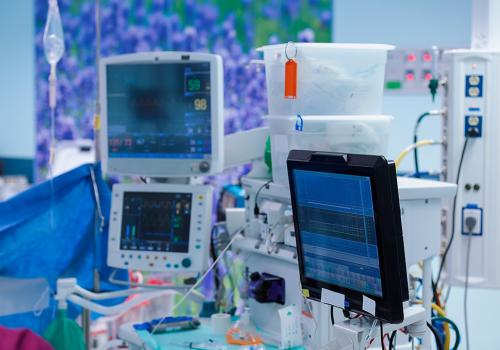The medical devices market manufacturing industry in the country is expected to expand up to $744.7 million, according to Trade and Industry Secretary Ramon M. Lopez. In a speech at the virtual “Make it Happen Philippines Campaign” soft launch, Lopez highlighted the prospects for this growing industry as he made a strong pitch for investments in 5 priority sectors – electronics, automotive, aerospace, copper, IT-BPM — the government is trying to develop and promote to foreign investors. “The Philippine medical device market is projected to expand up to $744.7 million,” said Lopez at the forum. He said the medical devices manufacturing is a growing industry supported by existence of supply chain for manufacturing. Some of the medical devices manufacturers fall under the electronics sector and the garment sectors where some of the industry players have repurposed their facilities to produce various medical devices and personal protective equipment (PPEs) to supply local demand. These PPEs include face masks, face shields, coveralls, and ventilators.
Exports for PPEs, particularly face masks, have been limited although demand in the domestic market is huge which is augmented by imports. So far, the newly-formed Confederation of Philippine Manufacturers of PPEs (CPMP) said they are investing an additional $36 million to further expand their capacities once the government has firmed up their sourcing deals with local producers of medical grade PPEs instead of importing these products. The additional investment is on top of the estimated $35 million already poured in by those that repurposed their operations to produce 57.6 the million a month of face masks and 3 million coveralls capacity per month at present. The repurposing program has also saved 7,450 jobs. Meantime, Lopez said that the government is pursuing the five priority sectors because of its huge export potential and jobs generation. For the electronics sector alone, Lopez said this industry is the country’s single largest export contributor with total exports in 2019 of $43 billion. It is the third largest contributor to the country’s manufacturing gross value added, accounting for 10.7 percent of the total manufacturing GVA in 2019.
The Philippines is also home to 500 semiconductor and electronics firms employing about 3.2 million direct and indirect workers. For copper, Lopez said it is one of the largest mineral resources in the Philippines. With reserves of around 4B metric tons, our country is one of the world’s largest producers of copper. “Our technical expertise in extraction means that we can produce a wide variety of copper goods to service many other industries. With multiple methods of extraction, the Philippines is well placed to manufacture and export a range of copper-based goods. These include Copper ore, Copper wires and cables, harnesses,” he said. “We are also home to a world-class smelting facility with the ability to create numerous copper-based products. The industry has the potential to extract other energy sources such as geothermal gasses. The resilience and determination of our workforce has contributed to the success of the industry with $1.9B-worth of copper exports in 2018.” He also reported of potential for expansion through the establishment of select world-class copper mines, a wire rod casting facility, and the promotion of higher-value copper products.
Locally, the Philippines only produce copper cathodes, which is the raw material for rolling/ extrusions to produce cables/ wires, electric motors, and transformers, among others. Meanwhile, the Leyte Industrial Development Estate (LIDE) has 2 international class ports that can service panamaxes of up to 60,000-70,000 tons). PASAR operates one and is already at 80 percent capacity. With regard to the Philippine automotive industry, he said the Philippines has already integrated with major global value chains. “Companies like Fujitsu, Continental and Yazaki already know we help make it happen in the Philippines,” he added. In 2019, the Philippines exported $4.1 billion in auto parts comprising of over 380 parts manufacturers—coupled with the strength of our die and molds, electronics, and IT-BPM sectors—we can respond quickly to changes in this fast-moving market.
For the aerospace industry, Lopez declared, “The aerospace industry in the Philippines is ready for take-off. Our aerospace industry is one of the fastest-growing in the Asia-Pacific region.” In 2019, the industry exported $780 million-worth of value of aerospace parts and components. This is a 7.54 percent annual growth from 2015 with biggest export markets being the US and Europe. “We are perfectly positioned to become the hub for manufacturing and aftermarket services in the Asia-Pacific aerospace industry. But our best-kept secret is that the Philippines is already home to Tier-1 suppliers of the world’s biggest aerospace manufacturers, like Boeing and Airbus,” he cited. The PH aerospace manufacturing capabilities include Flight control actuation systems, Interiors, lavatories, galleys, oxygen systems, panel assembly; and Product design engineering. Moreover, our existing supply chain has the capacity and capability to meet diverse industry requirements.
In addition, the country’s MRO (maintenance, repair, operation) offer is growing, too. “In 2019, we imported US$2.791B of aircraft and parts. Major international carriers are choosing to have their fleets serviced in the Philippines and we can cater to this rising demand. Our capabilities include Line Maintenance, Base Maintenance; and Aircraft inspections and structural repairs. “To sum this up, the Philippines is ready to become a state-of-the-art hub for aerospace,” he added. For the IT-BPM sector, Lopez noted the Philippines accounted for 15 percent share of the global market, making the Philippine IT-BPM sector is the second largest in the world. “We have the edge when it comes to voice-related services, as well as non-voice high-shared service support,” he said. With nearly 20 percent of the global IT-BPM sector outsourced, Lopez said the Philippines has been a cost competitive destination for major multinationals in the last two decades.
